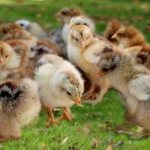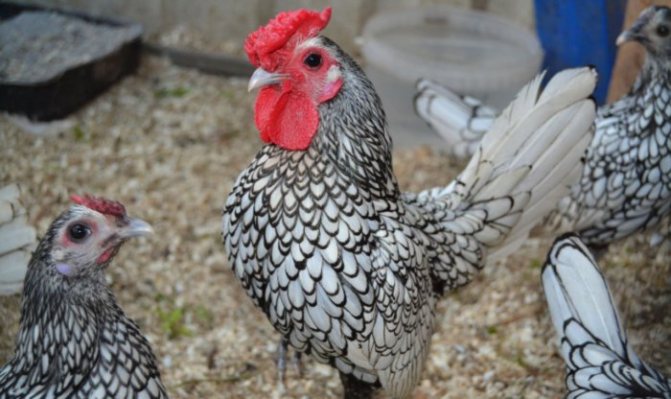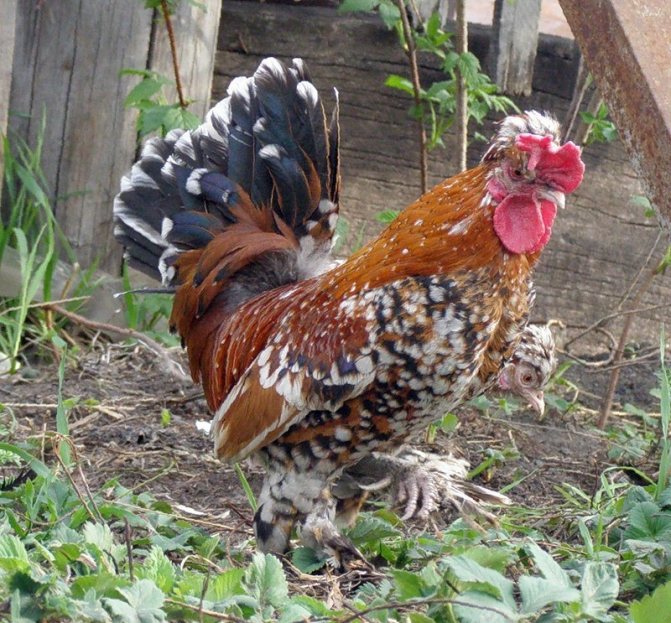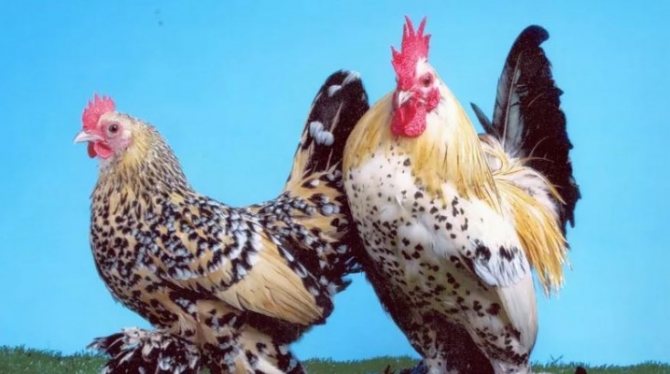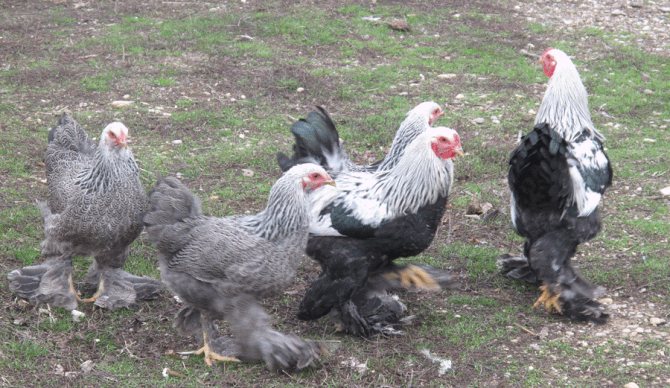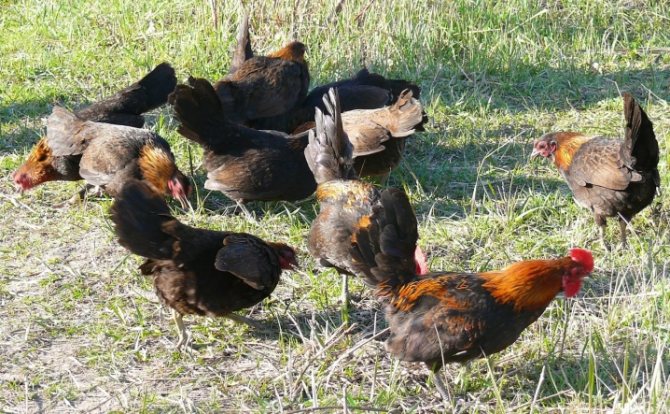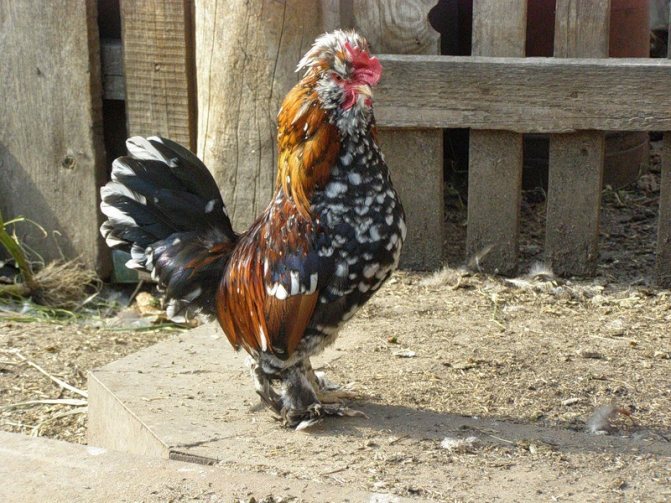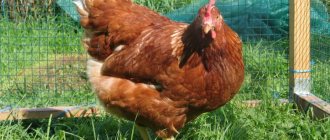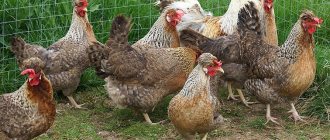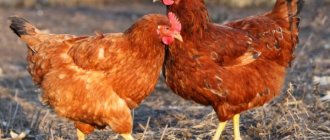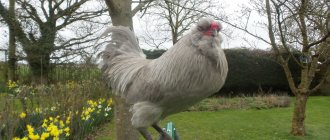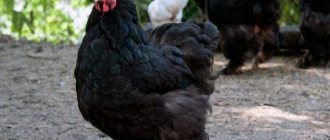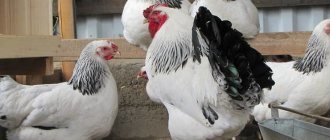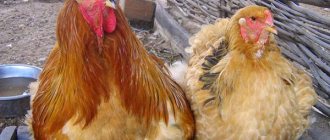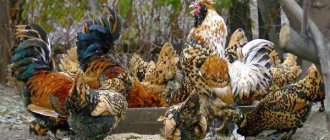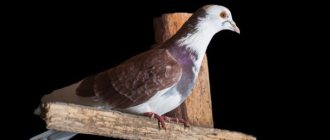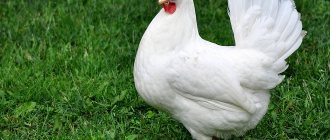Breeding ornamental chickens
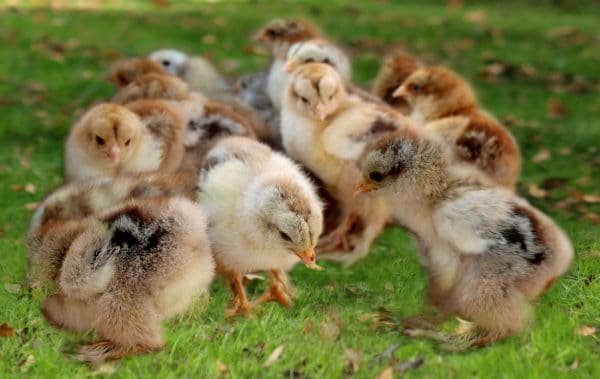
Chickens ornamental hens
To breed a bird, you need to observe several rules that will help to breed strong offspring:
- Parents must be with a clean pedigree.
- Eggs must be hatched in an incubator.
- It is necessary to equip a warm brooder and a room for young animals.
The idyllic picture, when a hen incubates and nurses offspring herself, is practically impossible, because many chickens lose their incubation instinct.
Features of the
Breeding chickens of ornamental breeds is quite difficult, especially for novice poultry breeders. Such chickens are very capricious to the diet and environment, so poultry farmers try to create especially comfortable conditions for their pets.
Decorative chickens need a balanced diet rich in vitamins and minerals. The feed should always be fresh, and yeast is added for better assimilation. Fresh vegetables are an obligatory component of the feed:
- cabbage;
- beet;
- carrot;
- sprouted wheat.
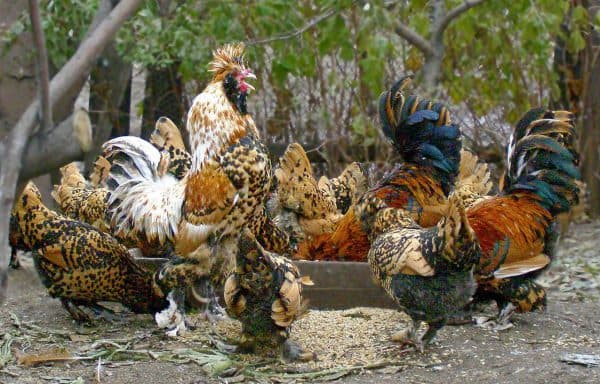

Decorative chickens are a true decoration for any home collection.
Some beautiful breeds of decorative chickens do not tolerate low temperatures well, so many of them cannot be bred in Russia.
Possible content problems
Decorative chickens are a decoration of the courtyard, as well as fresh and healthy eggs for the table, but there are a number of problems that should be taken into account when setting up chickens of different breeds.
If a person wants the chickens to walk in the fresh air throughout the site, please the eye, and at the same time retain their breed qualities, then the content of chickens of the same breed is permissible. Otherwise, cross-insemination will occur, and the future chicks will be mixed blood. But to solve this problem is simple: for each breed a separate room is made with a fenced outdoor yard.
Where can you buy representatives of the breed for breeding?
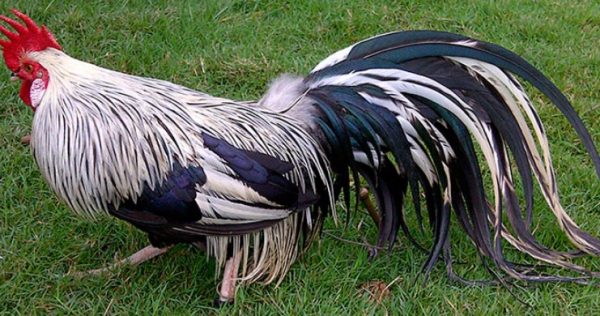

It is best to buy a bird in nurseries.
It is best to buy a bird in nurseries, and it is worthwhile to study in detail the activities of each specific seller. Because the word "breeder" is not enough to be considered a good supplier of strong and healthy birds. The farm must have the following parameters:
- The presence of at least 10 families living in separate chicken coops. Otherwise, incest occurs, which will give bad genetics to the offspring.
- Chicken coops must be clean, always with roosts. Outdoor and cage keeping does not give good offspring, since the bird cannot rest normally and, accordingly, becomes weaker.
- The bird must be vaccinated and the breeder must have the appropriate documentation.
- The seller must detail the feeding ration if adult chickens are purchased, otherwise, due to a nutritional failure, the bird may get stressed and die.
It is best to purchase decorative chickens on the recommendation and, importantly, in your region. When traveling long distances, the bird can become seriously ill if it is not taken care of on the way.
Advantages and disadvantages
The main advantage of decorative chickens is the beauty of plumage and unusual exterior. Also, many chickens can lay eggs well.
Among the disadvantages are the difficulty in acquiring high-quality breed chickens, a more complex chicken coop structure and hereditary diseases from which many birds die in the first years of life.
Varieties
Ornamental chickens are not suitable for industrial breeding. Groups of enthusiasts all over the world are engaged in the cultivation of such individuals. These birds differ from ordinary domestic chickens in some original external features. It can be a beautiful color, very long tail feathers or a tuft on the head. In some breeds of cockerels, instead of a classic comb, it grows on the head, very similar to a real crown.
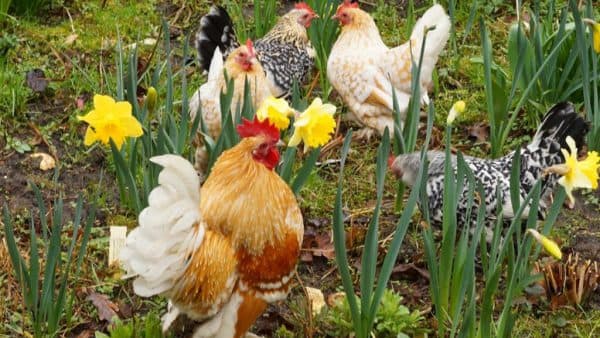

We now have the opportunity to choose from a variety of decorative poultry varieties.
Among the large number of original breeds, many poultry breeders pay special attention to two directions in ornamental poultry farming. This is breeding of dwarf and sports breeds.
Dwarf
Dwarf breeds of chickens are most often small copies of common domestic chickens. Small individuals are usually the result of long-term breeding work. Mini chickens do not need large poultry houses, consume little feed and are clean enough. Such breeds are distinguished by the following features:
- small size body weight;
- benevolence and lack of aggression towards other birds;
- low egg production.
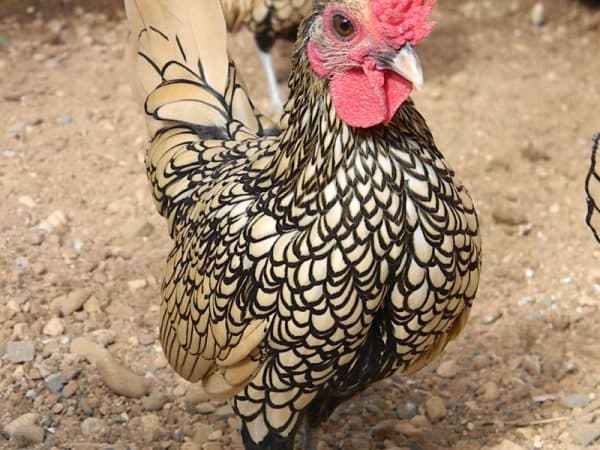

Dwarf chickens, mostly found in the wild in Japan.
Decorative hens of dwarf breeds weigh from 500 to 800 grams, and the weight of cockerels rarely exceeds 1 kilogram. Mostly miniature breeds are distinguished by a calm disposition and can coexist with other birds without conflict. Dwarf chickens can produce 100-140 eggs per year, weighing 30-40 grams.
Some dwarf breeds have no hatching instinct at all, so an incubator is required to breed them.
Sports
Sports or fighting chickens have been known since ancient times. Such breeds were cultivated for cockfighting, which are very popular in the countries of the Asian region. Now there are several sports breeds that are named after the place of their breeding. These are the following fighting breeds:
- malay;
- english;
- Orlovskaya;
- kulang.
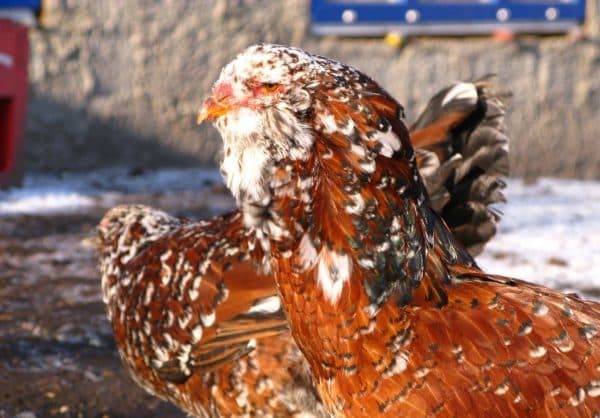

The Oryol breed of chickens is often used for sports and exhibitions.
Males of these breeds are distinguished by their large body mass and strong muscles.... Long legs, devoid of feather cover, are especially strong. Fighting bettas have a high level of aggression and a complete lack of fear. To participate in fights, they are trained for a long time and thoroughly.
Characteristics
Since most of the dwarf species came from large chickens with good productivity, such excellent qualities were passed on to these mini-individuals. With proper care and compliance with all requirements, one miniature laying hen can lay 120-130 eggs per year. The mass of one egg is from 41 to 50 g. It should be noted that not all large layers are capable of such a sufficiently high egg production.
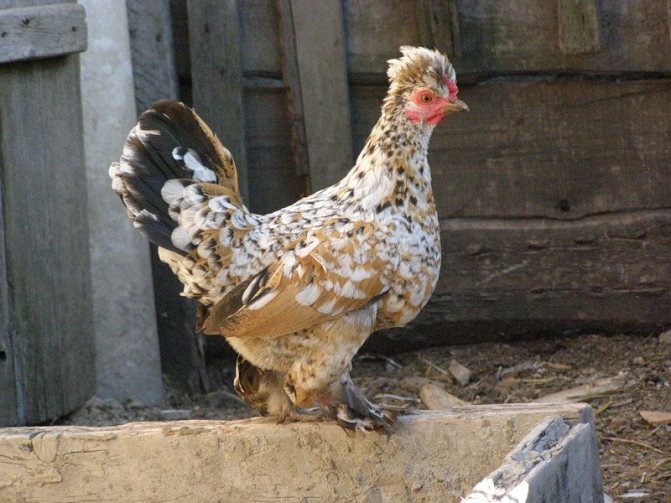

Miniature birds are distinguished by an unusual color of feathers. This happens because these individuals were created primarily as decorative breeds, therefore, when breeding, great importance was attached to the color of the plumage - so that it was bright, multi-colored. But not all mini-chickens were bred as decorative ones, a number of breeds were created specifically for cockfighting, so they have a rather aggressive character. Cockerels are active, cocky, they can start fights with their relatives and even bully to big birds.
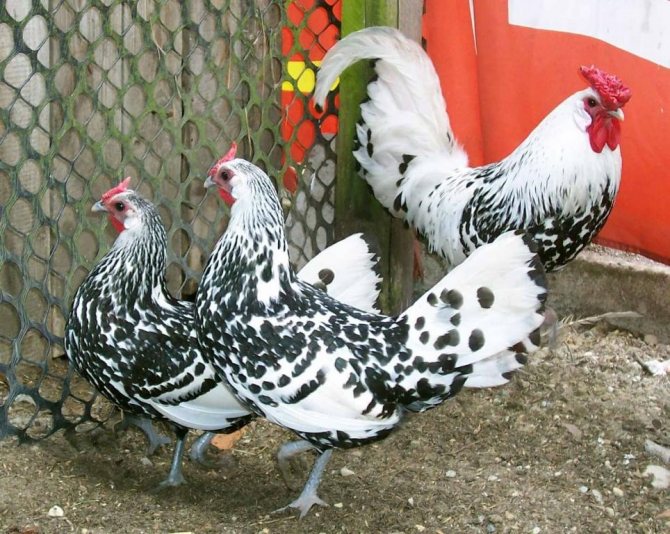

But these chickens are quite productive, there are breeds that are bred because of their high egg production or good indicators in the meat and egg direction. Before buying representatives of dwarf breeds for breeding on your farm, you should ask the seller which of the productivity categories these individuals belong to.
Laying hens of the following breeds are distinguished by a large number of eggs laid per year:
- Dutch
- Orlovskaya dwarf;
- Small Golosheyka.
These breeds produce 125 - 130 eggs per year.
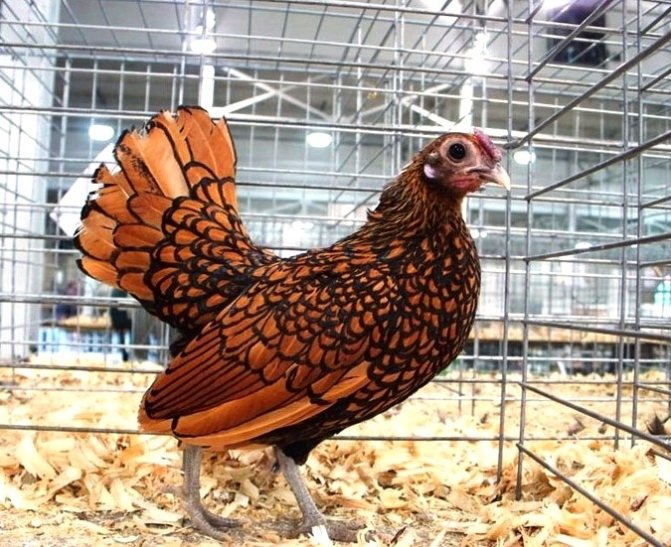

To raise dwarf chickens for their delicious meat, it is better to choose the following breeds:
Hamburg


Abozin II, in 1895 wrote: “Hamburg chickens are among the oldest breeds, the origin of which is unknown to us. The Roman writer Aldrovandi describes a breed of chickens called Gallina Turcica (Turkish chickens), very similar in features to modern silver-striped Hamburg chickens. This suggests that, firstly, the Hamburg chickens appeared in Europe from the East and, secondly, that the chickens described by Aldrovandi were the progenitors of the modern Hamburg chickens. For the first time, striped Hamburgers were brought to England from Holland, under the name of Dutch eternal layers. Subsequently, the chickens began to be called Hamburg, since they arrived from the port of Hamburg. Lancashire lunar chickens, Yorkshire pheasant chickens and black Spanish chickens participated in the creation of the breed. The first description of the breed was made by the Englishman Albin in 1740.
These are light, mobile chickens with a slender, elongated body on medium legs. The crest is rosy, with a characteristic tooth, directed backward, the continuation of the upper line of the crest and significantly spaced from the neck line. The earlobe is pure white, rounded. Beak, metatarsus and toes are bluish-slate.
The plumage is tight-fitting, having many colored varieties: silver and silver-spotted, silver and golden-striped, black, white, partridge, blue, fawn. The most popular are silver-spotted. Their main background is silvery-white, each feather ends in black, with a greenish tint spot. The rooster and hen have white feathers on the mane, and the rooster also has a black stripe in the middle of the lumbar feathers.
Live weight of males is 2.0-2.5 kg, chickens - 1.5-2.0 kg. Egg production is 140-180 eggs weighing 45-50 g and a shell of pure white color.
Breeds
Mostly decorative breeds of chickens are bred for beauty, although some of them are distinguished by normal egg production. There are widespread breeds, as well as very rare species of decorative chickens. Their representatives are distinguished by their exotic appearance and high cost.
Minorca
Minorca was bred on the Spanish island of Menorca and standardized in Russia in the early 20th century. It is a well developed, beautiful and graceful breed. Minorca is not suitable for industrial breeding, but if certain requirements are observed, it is quite suitable for private poultry houses. The breed was originally bred as an egg breed. From one laying hen during the year, you can get up to 200 eggs weighing up to 70 grams. The weight of a chicken can reach 3 kg, and a cockerel - 4 kg.
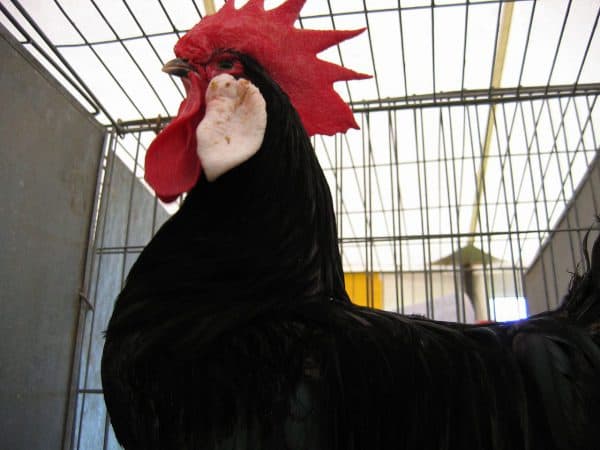

An amazing breed that delights with its grace, luxurious crest and white earrings that stand out brightly against a dark background - these are Minorca chickens.
This breed requires a warm, heated chicken coop. High humidity and drafts pose a great danger to birds. During the summer, an open-air enclosure should be set up for chickens. Birds are fearful and do not contact humans. They get along with other breeds quite peacefully.
The diet of minorocs must include animal products. It can be a special meal made from processed meat or fish products.
Paduan
This breed is very beautiful due to the original plumage, which forms a tuft-crown on the top of the head, and a lush "beard" in the lower part. Paduan chickens were bred in Europe in the middle of the 18th century. Individuals are distinguished by beautiful multi-colored plumage. Among the Paduan there are white, black, silvery, brown-yellow and gold birds. The most luxurious are considered golden-spotted birds, which are bred exclusively for decorative purposes. The Paduan breed is a universal meat and egg breed.Layers can produce up to 120 medium-sized eggs per year. Birds are extremely friendly and quickly get used to humans. They recognize their owners, easily take food from their hands and even sit on their shoulders.
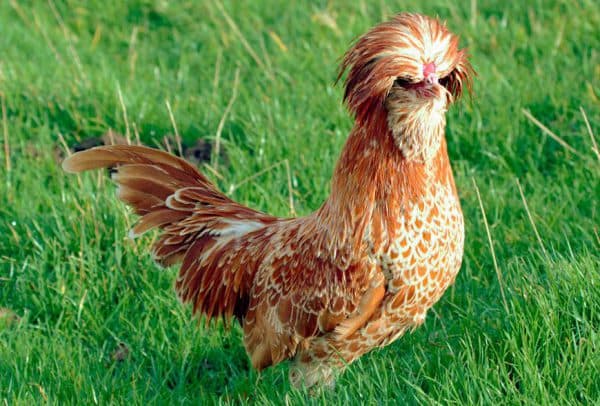

Paduanas are one of the rarest decorative chicken breeds. The characteristic details of their appearance are a lush crest and a neat beard that adorn the head.
Paduan birds need a well-insulated house. In winter, the floor of the house should be insulated with a layer of peat or straw. For feeding birds, you can use standard compound feed intended for ordinary chickens.
It is not recommended to add growth hormones, food additives and dyes to paduan chicken feed. These components reduce the immunity of individuals, and the chickens will get sick.
Chinese silk
This breed is considered one of the most ancient. They began to be bred in China over a thousand years ago. A distinctive feature of the Chinese silk chicken is that instead of feathers, the specimen pores with silky delicate fluff. They have asymmetrical five-toed legs, where two claws are in the back and three in the front. The head is framed by a tuft and sideburns. Females can be white, black, yellow and bluish in color. The meat of Chinese chickens has a dark color and, despite its external unattractiveness, it is very tender, tasty and healthy, since it contains more vitamins and useful microelements than the meat of ordinary chickens.
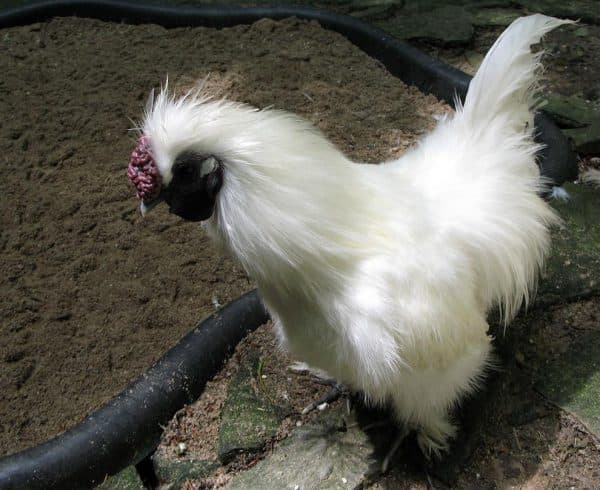

Chinese silk chickens have a thousand-year history. Homeland China. Chickens were called snares.
Chinese chickens are quite unpretentious and easily bred in the conditions of private poultry farms... They do not require special conditions of detention, but they need high-quality feed and hygienic standards in the place of residence. The chicken coop should be insulated for the winter and regularly cleaned of dirt and debris. The birds are friendly and easy to handle.
Laying hens are very calm and hatch chicks well, therefore eggs of other birds are often laid next to them.
English fighting
The English fighting breed was created specifically for cockfighting. Individuals have very long and strong legs. The cockerels have very developed musculature, especially the pectoral ones, with which they inflict strong jerking blows on the opponent. Such chickens are bred for participation in competitions, as well as for crossing with other breeds, which allows you to get new meat varieties. The plumage of individuals is mostly black or dark brown. All fighting roosters are the owners of the territory, therefore they should be bred in a separate enclosure. They are very aggressive and always attack first.
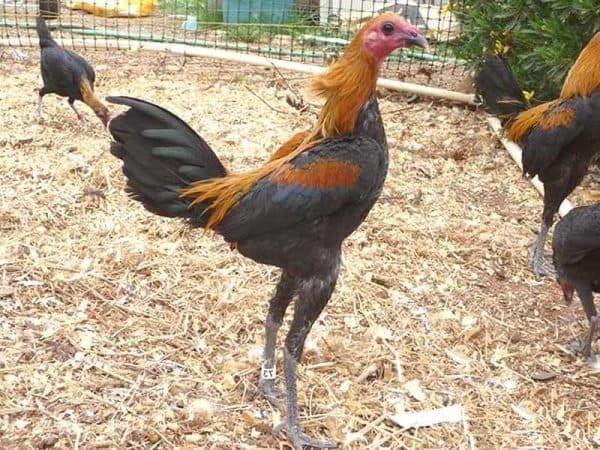

Modern English Fighters are a magnificent decoration of the estate and constant favorites of exhibitions, these are the only reasons for which they should be started.
For the proper development of fighting individuals, protein components and a large amount of vitamins must be present in their diet. They benefit from fresh grass and vitamin-rich vegetables.
Kulang
Kulang is a fighting breed that was bred several centuries ago in the territory of modern Uzbekistan. It is very popular in Bukhara and Samarkand regions. These individuals are intolerant of their opponent and very conflicted, but friendly towards the owner and attached to him. Chickens do not differ in high egg production and high-quality meat, therefore kulang cockerels are bred only for cockfighting. Some individuals can weigh up to 7 kg. Fighting birds are distinguished by a strong and strong chest, an elongated neck with a small head and long strong legs.
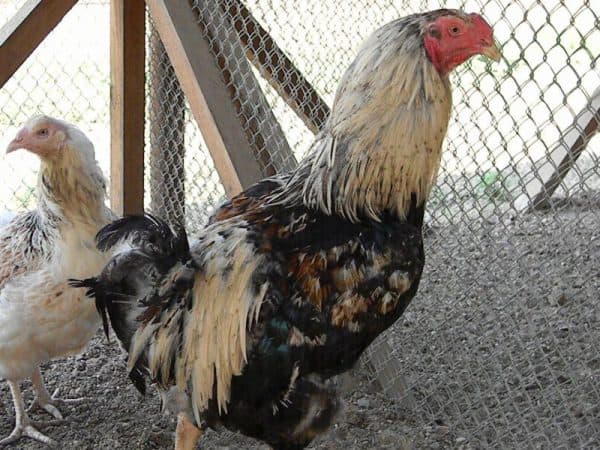

Kulangi and Daqans are one and the same fighting breed of chickens, created specifically for cockfighting.
Breeding kulangs is not too difficult, but they require a special diet rich in protein and vitamins. The main difficulties are associated with the preparation of the cock for fighting competitions.
Bentamki
It is customary to call bentams a whole group of chickens, which are distinguished by high productivity and unpretentiousness. These are individuals of small size, distinguished by a graceful build and beautiful plumage. In Russia, the following varieties of this breed are most common:
- chintz;
- Altai;
- nutty;
- sibright.
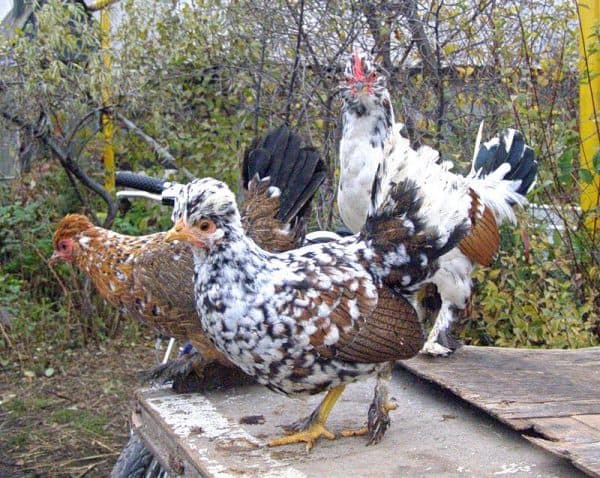

Thanks to their maternal instinct, bantams have been preserved in the yards, over the years they have become noticeably larger.
The calico variety is grown throughout the country. Individuals have a reddish-brown background, on which white feathers are scattered. Cockerels have black feathers with a green tint on their tail. Altai or Barnaul chickens are distinguished by their variegated plumage and a tuft on their heads. Walnut bantams have a darker plumage than chintz ones. Sibright differs from other varieties in very beautiful plumage, where golden feathers have a black edging.
All bantams are distinguished by delicious and tender dietary meat, and their eggs are very nutritious and practically free of fat. In winter, birds can be kept in an insulated room equipped with roosts for rest, and in warm weather, an open aviary is suitable for them. Bantam chickens require a balanced diet with vitamins and microelements. Chickens, before replacing plumage, it is customary to feed minced meat from waste meat products.
All bentams fly perfectly, so the enclosure fence should be at least 2.5 meters.
Shabo
This breed was developed in Japan in the 16th and 17th centuries. Then it was brought to China, and birds appeared in Europe in the 19th century. The shabo standard implies that individuals have short legs, which indicates the purity of the blood. Experienced poultry breeders, when selecting a pair, choose one individual with short legs, and another with longer ones. This allows you to get strong and viable offspring, since the two short-legged parents will have very weak chickens.
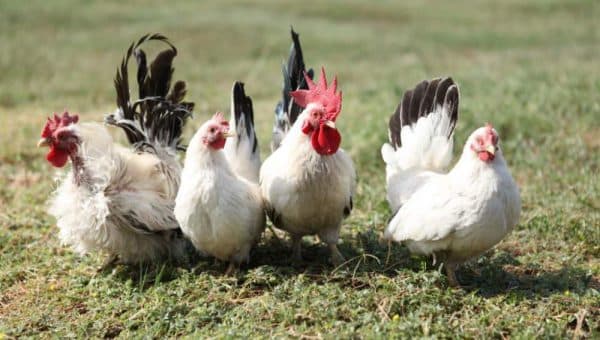

Chickens of the Shabo breed amaze with their grace and beauty, therefore they have easily gained popularity among fans of decorative birds around the world.
Shabo are very hardy birds, but breeding them requires a warm house. Birds can die from cold and draft. Small chickens consume a minimum of feed, while being distinguished by good egg production. The eggs are small, but one layer per year can produce up to 150-170 eggs. Females are very responsible for hatching chicks, so they can lay eggs of other birds.
Dutch white-crested
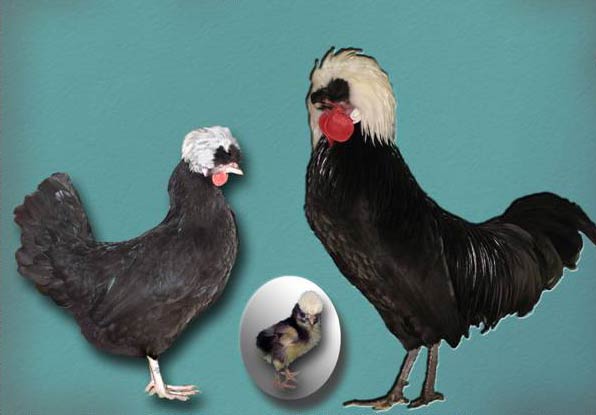

The breed is of a very old, unclear origin. One of the versions is that it arose from the improvement of the Polish Corydalis chickens in Holland. Known for paintings by artists of the 16th century.
Chickens of this breed are more decorative, but at the same time they have good egg production: in the first year, 140 eggs, in the second - 100 eggs. The minimum egg weight is 50 g, the shell is white.
The mass of chickens is 1.5-2.0 kg, males are 2.0-2.5 kg. The head is medium in size with a high swelling of the skull, on which a magnificent crest is located. The crest is white, large, dense, long feathers, which fall beautifully back on both sides of the head, do not disintegrate, do not form parting and rounded feathers. The crest leaves his eyes open and does not interfere with looking. The front feathers form a contrasting colored small spot on the forehead, shaped like a butterfly - a moth. The color of the "moth" corresponds to the color of the main plumage. The lower feathers support the crest, in the same way the feathers of the "moth" support the crest.
The bill is not long, with high nostrils, the color of the bill depends on the color of the plumage. The ridge is completely absent. The eyes are red or brown. The face is red, unfeathered. The lobes are small, white. The body is retracted, slightly falling towards the tail. The back is of medium length with long lumbar feathers. The tail is very tight, with long, beautifully curved and wide braids.With lush coverts, high but not steep, set at an angle of 450. The belly is well developed. The wings are moderately long, raised high. The lower legs are gracefully shaped, with adjoining plumage. Metatarsus of medium length, non-feathered. The color of the plumage depends on the color of the plumage. The plumage is tight-fitting, without "pillows".
The color of the plumage can be black, white, blue.
Feeding
For beautiful plumage and reproduction, birds must eat well.
The basis of the diet is considered to be grain, the proportion of which in the feed is about half of the entire portion. Preference is given to barley and oats. Corn and wheat grains can be added to the feed, but not more than 30% of all cereals.
In addition, it is necessary to provide a sufficient amount of succulent feed. These can be vegetables, fruits, herbs. Legumes - beans, lupine, peas - will give pets vegetable protein. In winter, the juicy part is replaced with grass flour. Proteins of animal origin are found in various small animals - worms, beetles.
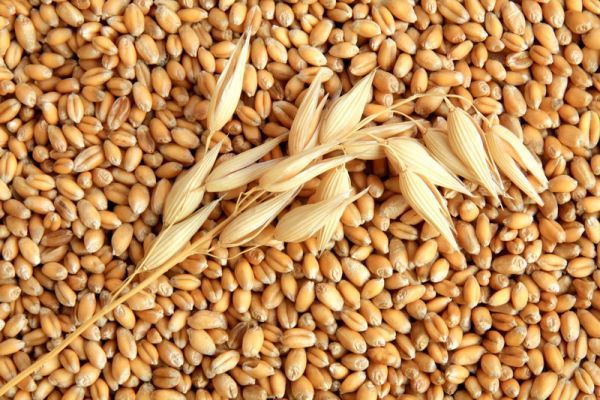

The basis of the diet is cereals
Attention! It is important that with food enough B vitamins, the source of which are yeast and legumes, enter the body.
Fodder yeast, dry or diluted with water, is added directly to food. From mineral supplements, crushed shells and eggshells, where there is a lot of calcium, are shown. In the cold season, veterinary vitamin complexes should be added to strengthen the immune system and prevent the occurrence of diseases.
conclusions
- Many types of dwarf chickens are beneficial to be kept on almost any scale because they consume relatively little food and do not require large housing facilities.
- Most dwarf breeds have excellent decorative properties.
- The bird is distinguished by a relatively low productivity, however, they quickly reach sexual maturity.
- An important disadvantage of keeping dwarf chickens is the difficulty in maintaining dryness and cleanliness in the chicken coop due to weak immunity and small height of individuals.

